
|
The Society of Folk Dance Historians (SFDH)
Folk Dance Etiquette
[
Home |
About |
Encyclopedia | CLICK AN IMAGE TO ENLARGE |
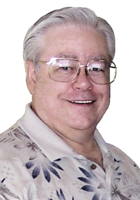
|
DURING TEACHING
- The teacher needs your cooperation. Keep quiet in class or go outside to talk, unless you have a question of the teacher.
- Pay attention – this is the best way to learn new dances.
- Don't "correct" the teacher. Later on, you might offer constructive feedback, suggestions, comments, likes, and dislikes in private.
- Do not try to teach your neighbor when someone else is teaching the class.
- Don't be discouraged if you don't learn a dance immediately – smile and have fun anyway.
- If you already know the dance being taught, take the class anyway. Your knowledge can help others near you who are struggling to learn.
- Some tunes are used for more than one dance, and some dances are done differently from "village to village." Don't confuse other students with different step motifs than those being taught; save them for open dancing.
- When you are confident that you can do the rhythm, steps, and style of a dance and can be a good model for others, request the dance and lead it.
- Please be quiet so the teacher can be heard by all dancers.
DURING LINE AND CIRCLE DANCING
- Line dances have leaders. Don't join at the front of a line (which may be at the left or the right – check before joining). Instead, join in the middle, as "both" ends may have leaders, which is typical in Serbian dancing.
- Some dances are meant to be done in short lines or small circles, so do not be offended if you are excluded from a group – just try another line or form your own.
- Follow the leader of the line in which you are dancing unless it is a dance in which you may do steps individually, such as "U šest koraka."
- If you don't know a line or circle dance or cannot keep up with the steps, drop out and follow in back. People in the "old country" learn dances this way, why not you? Try to pick a good dancer to emulate. You'll have a clearer view, and the folks who do know it will be able to dance it.
- When you really know the dance, try to join at the beginning of the dance. Be considerate; avoid breaking lines and consider going to the tail end of the line.
- Join a closed circle dance anywhere in the circle, but be sensitive to the fact that certain people may prefer to dance together. Don't force yourself in where people are squeezed together; look for a different place to join.
- When a dance is done in a shoulder hold, belt hold, or basket hold, you'll be more comfortable dancing next to someone near you own height (and so will they).
- If a dance is done in a front or back basket hold, don't cross your own arms – stretch them out to your sides to join hands with the dancer on the other side of the dancer next to you.
- Carry your own weight . . . we hold on to each other to transmit the "flow" of the dance, not to support ourselves. It is greatly appreciated by everyone when you don't hang on the shoulders, arms, or hands of the people on either side of you. Do not clutch your neighbor in a grip of death nor using your thumbs on his or her fingers as you would screwdrive handle. These practices can be distracting and even painful.
- Most line and circle dances move to the right, sometimes called line of dance or line of direction (LOD), but some move to the left. Because it is important that everyone goes in the same direction, at more or less the same speed, keep moving and watch where you're going.
- If you must leave a line or circle in mid-dance, it helps if you join the hands together of the dancers who were on either side of you.
- Dont push or pull your neighbor as it may be dangerous, depending on that person's physical condition.
- Be careful that your rings do not hurt your neighbors in little-finger dances.
DURING COUPLE DANCING
- Don't be offended if you're turned down when asking someone to dance. According to tradition, the only graceful way of declining a dance is either (a) you do not know the dance, (b) you need to take a rest, or (c) you have promised the dance to someone else.
- Never turn down a request to dance, then accept another request for the same dance (no matter how much you want to dance with that second person!).
- If you are asked to dance and don't know that particular dance, let your prospective partner know that before accepting.
- Anyone may ask anyone else to dance.
- Try not to push your partner beyond that person's ability and capability.
- If you feel your partner is being overzealous, say so! If that doesn't help, it is okay to stop dancing.
- It is good to make eye contact with your partner but no one likes penetrating stares.
- Don't leave your partner in the middle of a set of dances without a very good reason!
- Know the local protocol when it comes to monopolizing a partner's time or reserving dances ahead of time. In some dance sessions, you are expected to dance the first and last couple dances with the person you came with and dance all the others with someone else. In others, it is considered rude to book dances ahead.
- The faster "lanes" are toward the outside of the line of dance or line of direction (LOD). The slower "lanes" are more toward the center.
- When dancing in the "outside lanes" of the floor, do not back up, do not dance across the flow. If you find that you do this often, get someone to explain to you how to avoid doing so and consciously follow their advice.
- In an elbow hold, such as for a swing, cup your hand with your thumb tucked alongside your index finger around your partner's elbow. Do not grasp the elbow with your thumb on top as it can bruise badly.
- If you are not dancing, show respect to those who are by not walking through the busy dance floor and by staying clear of the dance space. First priority goes to the dance and dancers – give them room.
- If you are doing non "line-of-dance" steps, move toward the center.
- Progressive dances should be danced in a continuous forward movement in line of dance/line of direction.
- The safety of your partner and surrounding dancers is your first concern. Both leader and follower should always be alert to the presence of other dancers in front, to the sides, and in back to help avoid collisions.
- Followers . . . do not "backlead" (like back-seat driving, it is never appreciated). Not only does it make leading more difficult, it also makes it more difficult for the leading partner to avoid collisions.
- For turning dances, be sure that your shoes don't have rubber soles that can hurt your knees.
- Use clean dance shoes without spiked heels for safety and to protect the floor.
- Accompany your partner off the floor instead of leaving that person in the middle.
DURING SQUARE AND SET DANCES
- When squaring up, if your square or set needs more dancers, the convention is to hold up fingers indicating the number of couples needed. At singles clubs, you also may see bent or crossed fingers requesting "half" a couple (although, the usual procedure is to find a partner before trying to form a square or set).
- Always join a contra line or longways set at the foot of the set (the end away from the music).
- If your square or set breaks down, don't get angry – we all make mistakes sometimes.
- Use gentle handholds! It is important to establish hand contact with adjacent dancers in your formation, but you don't have to bruise them to do it.
- After the dance is over, shake hands with the others in your square or set and thank them, instead of just walking away.
BASIC DRESS CODE
Some folk dance sessions have dress codes, especially when it comes to shoes that won't harm the dance floor. If it is your first time at a particular dance session, it is best to call ahead for information. In general, clothing basics are:
- Wear comfortable, casual, fresh attire for general folk dancing.
- Wear soft-soled, non-marking shoes.
- A belt is a must for some dances – bring one if you normally don't wear one while dancing.
- During dancing, don't wear sharp jewelry, such as engagement rings, and keep jewelry to a minimum to avoid getting it caught in someone's loose clothing or long hair.
- Very long hair may be best worn tied back.
- If you perspire heavily during dancing, consider taking extra shirts.
- For dance types other than general folk dancing, you might be expected to wear such clothing as dressy but sexy (for Latin venues), semi-formal clothing in black or dark themes (for tango sessions), western garb (for country-western dances), formal wear (for some ballroom sessions), neat and chic (for swing groups), and vintage outfits (for vintage dances).
BASIC HYGIENE
- Dancing involves a lot of close contact; try not to gross out your fellow dancers by having icky stuff on your hands, eating three heads of raw garlic for dinner, or not having taken a shower or brushed your teeth in recent memory.
- Use a deodorant, if necessary.
- Avoid wearing perfume, as some people are allergic to or are very sensitive to these chemicals.
- If you notice that your partner is hesitant to get into proper dance hold, is holding his or her breath, bolts from the dance floor once the dance is over and refuses to dance with you again, take the hint.
FAMILIES AND CHILDREN
- Because the folk dance community is aging, we encourage parents, young folks, and children to participate, which can only happen if they feel welcome.
- Never discipline children for whom you are not responsible – take a problem up with the parents instead.
- You can expect some noise when children are present, so before taking action, see if you can position yourself to minimize the distraction.
- If children are loud during teaching, ask the teacher to speak louder.
- Treat young people with the same respect you extend to the adults.
- Never tickle children, even if they ask for it, and never laugh at them, laugh with them.
IN GENERAL
- Welcome new people to the dance by introducing yourself.
- Punctuality is always appreciated at social events.
- Normal politeness is appropriate at folk dancing. "Please" and "Thank you" are always in vogue.
- We bring an enormous range of ability and fitness levels to folk dancing, so be tolerant of others. Never make disparaging remarks about other dancers while at a class or club. Even folk dancers are human and we all make mistakes.
- Don't be offended if someone asks to be excused from a conversation to participate in a dance. After all, dancing is why folks are there.
- Be aware of others standing or dancing near you.
- Learn the names of the dances you like and request them by name rather than "You know, the one that goes la-la-la and has two hops."
- Please do not touch the teacher's expensive, easily broken, personal sound equipment.
- Folk dance is a social pastime, so relax and have fun. Keep "showboating" to a minimum.
- Don't get discouraged if a dance seems hard to do.
- Please don't ingest alcohol or other drugs before dancing that impair your coordination or memory.
- Avoid wearing big rings, brooches, or other accessories that may get caught.
- Avoid sleeveless shirts and strapped dresses.
- Wear something comfortable for dancing; informal wear is fine.
- Today's beginners are the good dancers of tomorrow, so be nice to them and dance with them.
- Respect other dancers and leaders and treat everyone with courtesy.
FINALLY
- Make it a practice to thank guests for coming, instructors for teaching, program leaders for leading, and everyone else who made your dance experience a pleasant one. Smile often; have fun.
DOCUMENTS
- Alcohol and the Dance, an article.
- Beginners - Behavior Basics, an article.
- Beginners - Care and Feeding, an article.
- Dick Oakes, an article.
- I Want to Hold Your Hand, an article.
- Smile, an article.
Used with permission of the author.
POSTERS
Nancy McGowan Pruitt drew these Folk Dance Etiquette Posters in the late 1960s for the Austin International Folk Dancers and Texas Camp. The Society of Folk Dance Historians (SFDH) Archives has only someone's poor copies, so Ron Houston scanned and pixel-edited these.
CLICK AN IMAGE TO ENLARGE
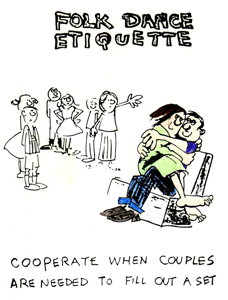

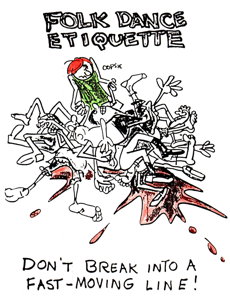
|
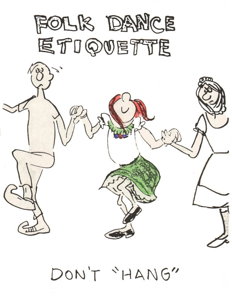

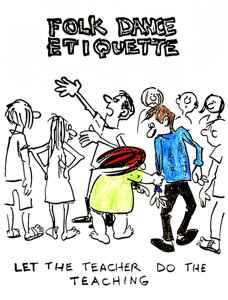
|
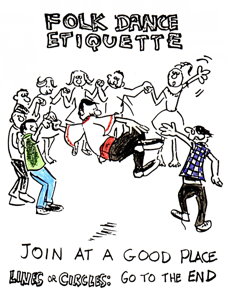

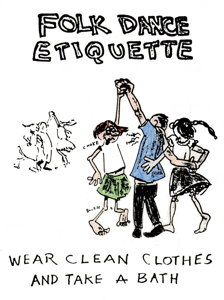
|
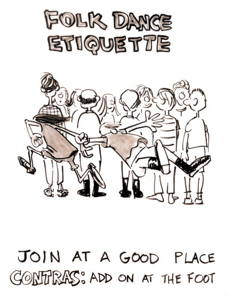

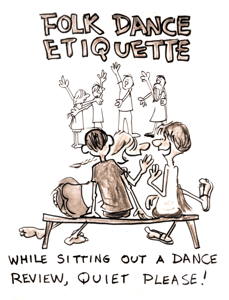
|
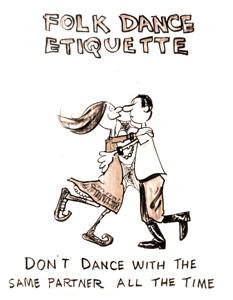
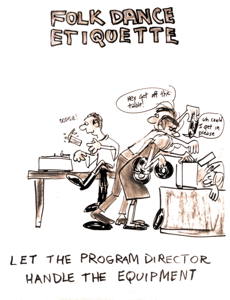
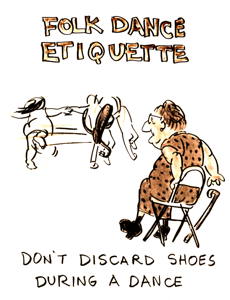
|
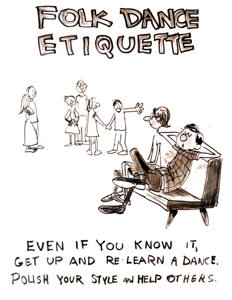
|
This page © 2018 by Ron Houston.
Please do not copy any part of this page without including this copyright notice.
Please do not copy small portions out of context.
Please do not copy large portions without permission from Ron Houston.